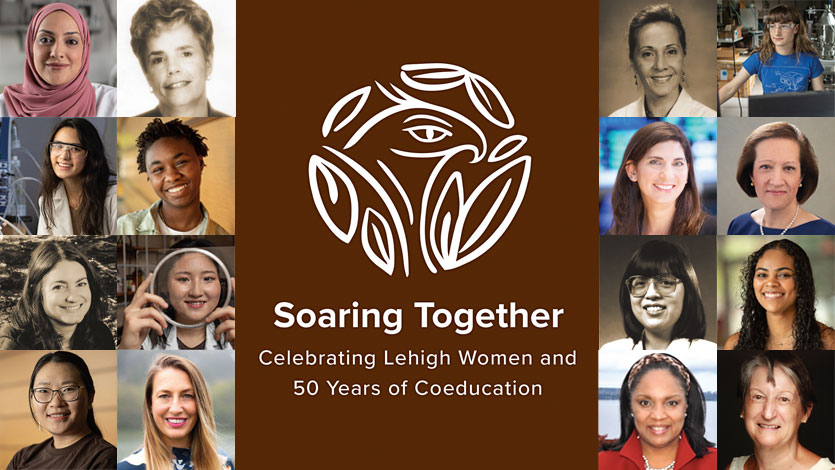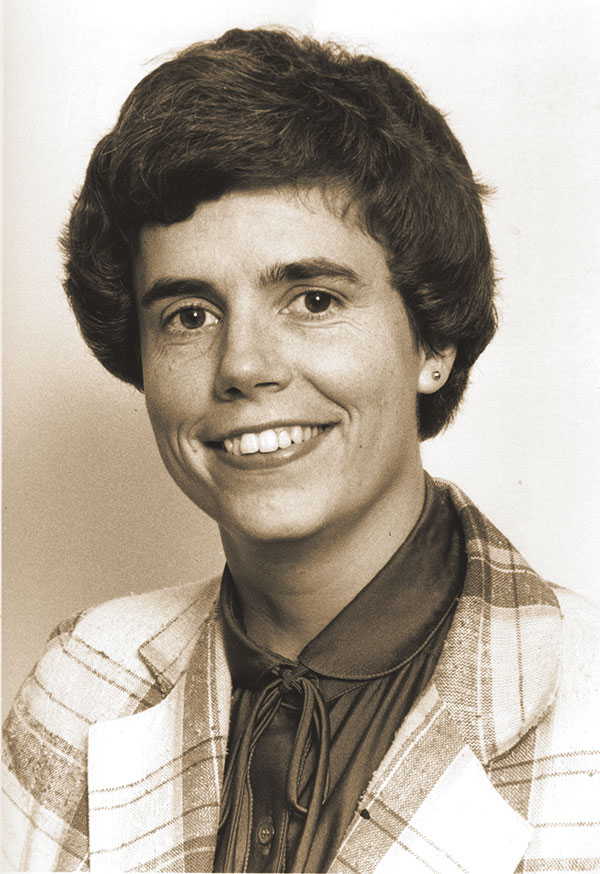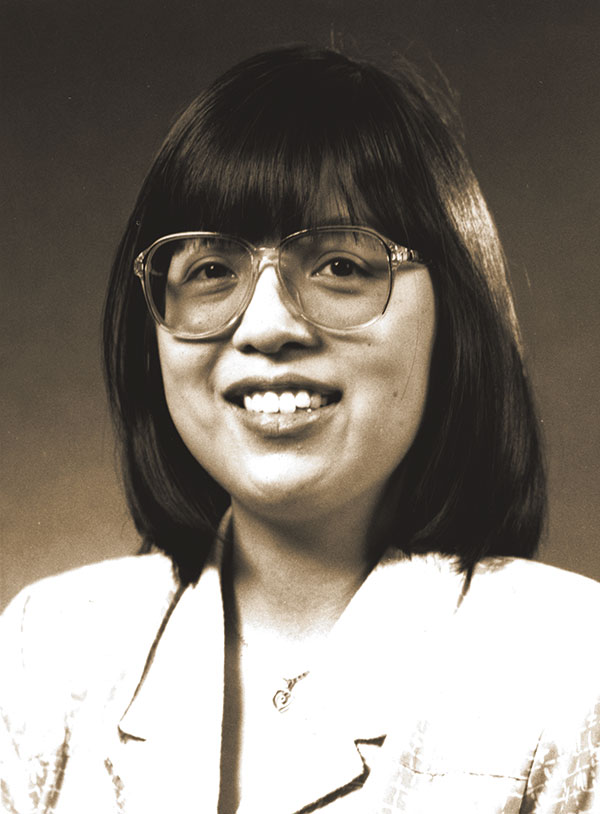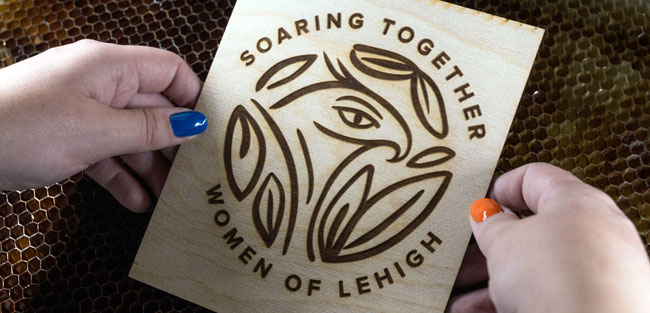
|
By Christine Fennessy | Photography by Douglas Benedict/Academic Image |
It isn’t easy being the first person to do something. In the case of Patti Ota, Lehigh’s first woman engineering faculty member, that fact is an understatement.
|
Patti Ota |
In 1971, Ota was finishing up her PhD at the University of Pennsylvania when her dissertation supervisor recommended her for an adjunct position teaching electrical engineering at Lehigh.
As she walked across campus that first day, she wasn’t thinking about how she was about to make history. Having completed her master’s in electrical engineering and her PhD in computer science at Penn, Ota was used to being the only woman in most things she did—and what that meant.
“If you were a woman back then,” she says, “you knew that if you were going to compete in this, let’s call it ‘man’s world,’ you knew that all kinds of things were going to happen, and you just had to grin and bear it.”
For Ota, the grinning and bearing it started before she even made it through the front door of Packard Lab.
“I remember walking up the steps to the main entrance, and having two of my male colleagues greet me, and tell me that I shouldn’t have been hired.”
This is odd, she thought to herself. But it wasn’t surprising, and so she kept walking, went through the door, and joined roughly 200 men on the engineering faculty. She would be the only woman for nearly a decade.
The same year that Ota unwittingly made history, Lehigh itself was doing the same by opening up undergraduate education to women. This year marks the 50th anniversary of that 1971 milestone. The university is commemorating the occasion through Soaring Together, a multiyear celebration that is recognizing the impact of all women on campus—past, present, and future.
For Lehigh Engineering, that impact began, in many ways, with Ota, and it continues today with 33 women on the faculty of 154. Representation in the Rossin College’s student body also continues to grow: 32 percent of all undergraduates enrolled in engineering are women, a level that exceeds the national average (in 2019) of 23.8 percent, according to the American Society for Engineering Education.
But to appreciate where we’re at, it’s good to know where we’ve been. And to continue to increase the number of women in engineering—and ensure an equitable future for all engineering students, faculty members, and staff—it helps to understand the challenges, the efforts, and the wins inside our community today.
Ota went on the record with The Brown and White back in 1982 saying that it took her six years to feel comfortable on campus. In that time, she says she faced some form of harassment and/or discrimination nearly every day. Her car tires were slashed—twice. Vulgar and demeaning graffiti was scrawled on her office door. (“I had to ask my colleague, ‘What does this word mean?’” she says.) When she complained about pay inequity, she says she was told, “We all know that women don’t work as hard as men.” (To which she says she responded, “Please tell me what this other individual is doing that I’m not doing.” She got no response. And then she got a pay bump.) She says she wasn’t allowed to go to conferences (“I was told the wives of my male colleagues would get jealous.”) She says she was informed that if she wanted tenure, she had to sit through all the undergraduate electrical engineering courses, do all the homework, and take all the exams. She says faculty and departmental meetings always started with the word, “Gentlemen.” When she objected to it, she says the reply was, “Only that type of language is appropriate in engineering.” There were no women’s restrooms in Packard, so she had to wait until the men’s room was empty and then recruit a male student to stand guard.
So, how in the world was she able to thrive in that environment?
“It’s very hard to explain in today’s culture, but I accepted it,” she says. “It was not surprising. You expected to be treated differently as a woman.”
Things did change, and Ota herself became an instrument of that change. After getting tenure in 1980, she began a long administrative career that saw her rise from assistant to the provost to interim provost to vice provost (with a couple dean appointments along the way). As an administrator, she had the power to change the culture.
She’s particularly proud of implementing a maternity leave policy. Back in 1976, when her second son was born, she had taught on a Wednesday, delivered him the following night, and was back in the office full time by Monday (when, she says, she was met by a colleague who said, “It must be nice to be a woman, have a baby, and get a few days off.”). As acting provost, Ota was interviewing a woman for a position, and when the candidate asked about the university’s policy for new mothers, which was nonexistent, Ota made one up on the spot.
“That night, I went home, wrote a memo to the faculty, and said, ‘Here’s our new maternity policy,’” she says. “And no one questioned it.”
Throughout the ’80s and ’90s, Ota became the point person who handled all instances of sexual harassment and racism on campus. She created the women’s studies department, hired the first Black woman director of admissions, and was the first woman to receive the Hillman Faculty Award for lifetime achievement. By the time she left Lehigh for the University of Arizona in 1999, she saw women in leadership positions across the university, and a far more balanced ratio of female to male students.
|
Helen Chan |
For other women engineering faculty in those early years, it was an entirely different experience. Helen Chan came to Lehigh as a postdoc in 1982 and joined the materials science faculty in 1986 as its first female professor.
“I always felt it was a very welcoming place,” she says.
There were little things. Like the time someone outside the university was sitting in on a faculty meeting and asked if she had made the cookies that were on the table. “I don’t think he meant anything bad by it, but it’s a little bit of an assumption, isn’t it?” says Chan, who is now the New Jersey Zinc Professor in the Department of Materials Science and Engineering.
She does remember feeling grateful when the maternity policy went into effect, and the tenure clock stopped for female faculty. And it’s a trivial example, she says, but when she was department chair in the fall of 2012, she achieved “potty parity” in Whitaker Lab. “It had just always struck me that we had five floors, and the only ladies’ room was on the third floor,” she says. “And by that point, we had so many more female students and female faculty. So I brought it up to the head of facilities who immediately responded with saying, ‘We can take care of this.’” The university also added a lactation room.
The same year Chan became the first woman faculty member in materials science, Sibel Pamukcu became the first for the civil engineering department. She recalls Patti Ota as a driving force for change. “She was the one bringing more women not only into engineering, but into the sciences, mathematics, and physics—places where women traditionally were not on the faculty,” says Pamukcu, who is now a professor in the department.
Like Ota, Pamukcu was used to being one of very few women throughout her academic career, and so being the first in her department wasn’t all that unusual. And also like Ota, it took Pamukcu a long time to get comfortable in her position. But for her, it wasn’t about enduring sexism and discrimination, but lacking the confidence to say no to her colleagues’ many requests.
“I felt like I had to be loyal here and loyal there, rather than being loyal to myself,” she says. “That happens to a lot of young faculty.”
|
Sibel Pamukcu |
Fortunately, Pamukcu had an excellent friend and mentor in her department chair, Irwin Kugelman, who advised her on how to negotiate the gauntlet of academic demands.
Pamukcu’s experience has, by extension, now helped countless young faculty members, particularly women. In 2010, Pamukcu was part of a team that submitted a proposal for the National Science Foundation’s ADVANCE Institutional Transformation Grant. The overarching goal of the grant was to increase the number of women faculty in STEM.
It was a goal the university was eager to pursue. And in doing her research for the proposal, Pamukcu was surprised by just how low the institution ranked when it came to women STEM faculty. “We were way down in the lower percentile for universities of our size,” she says.
The team was successful. Lehigh was one of just seven recipients of the ADVANCE grant. Their proposal, “Building community beyond academic departments,” likely stood out, she says, because it recommended interdisciplinary research as a means by which women could meet each other across departments and colleges, form a community, and potentially work together on projects.
“At the time, it was very hard to bring about this sense of community. If a woman came to civil engineering, she would have felt pretty isolated, bound to her own labs and her own students,” says Pamukcu. “We wanted to promote community through interdisciplinary research, through mentorship, meetings, and a variety of programs. Creating that environment would help us not only attract faculty, but retain them, and help them advance in their careers.”
Lehigh ADVANCE pursued numerous goals over the five years it was funded by the NSF (it’s now supported by the university): increasing women in STEM faculty positions; supporting their advancement; studying interdisciplinarity as a strategy for gender equity and leading national dialogue around that approach; and transforming the university’s culture through policies and programs.
The program built a Women in Science and Engineering (LU-WISE) community that hosted regular formal and informal gatherings, created a mentoring network, held seminars and workshops focused on research and professional development issues, provided best practices and support to departments for recruiting, and reviewed policies around promotion and tenure to improve retention.
Pamukcu co-directed ADVANCE until 2013 and then “handed the baton,” as she likes to say, to Kristen Jellison, who now co-directs the program with Marci Levine Morefield, PhD, who works in the Office of the Provost. Jellison, now a professor of civil and environmental engineering, accepted the position because she knew from experience that the program works.
|
Kristen Jellison |
After becoming tenured in 2010, Jellison had a couple of really low years. “I was teaching new classes, running a research lab, advising students, and serving on lots of committees,” she says. “I was up working until 1 o’clock in the morning, then up again at five with my kids. I was exhausted, drained, and had very low morale. And so I turned to ADVANCE.”
She got involved with the community. She attended professional development workshops on time management, imposter syndrome, and work-life balance. She got tips and advice, support and encouragement. But most of all, she got validation. “You feel like something’s wrong with you. Like, I just can’t cut it. I’m not made to do this. Getting involved with ADVANCE changed my mindset, and made me realize that a lot of people were dealing with similar things, and that helped a lot.”
Eight years into her tenure as co-director, Jellison has seen real change. In 2010, for example, 16 percent of Lehigh’s tenure-track faculty in STEM were women. Now they make up about 26 percent. ADVANCE runs yearly workshops for search committees to ensure an equitable recruitment process, and their “toolkit” includes how to write job descriptions to diversify the pool of applicants, how to evaluate candidates in a way that minimizes or eliminates implicit biases, and how to treat candidates once they arrive on campus.
“We have seen big differences at every level of the process, from the makeup of the pool that makes the cut, to who gets invited to campus, to who is getting offers,” she says.
As Jellison knows well, it’s not just about getting more women on campus, but supporting them once they’re here. To that end, they’ve expanded the reach of LU-WISE. There are now versions for undergraduates, graduate students, and faculty. Women faculty from across the university get together once a month for lunch, workshops, and guest speakers (during the pandemic lockdown, there were a lot of Zoom coffee hours). Jellison says she and her co-director Morefield poll the community at the beginning of the academic year for topics of interest and work hard to deliver that content at the monthly sessions.
They’ve also instituted a mentoring program, called INC, which stands for Interdisciplinary Network Committees. New professors are paired with a senior faculty member in their department, and with another mentor/mentee pair from another department. “This gives them a network of mentors,” says Jellison.
They’ve run a couple of grant-funded mid-career mentoring programs and are working on establishing a permanent such program. They’re also starting the conversation around criteria for promotion.
“The associate professor with tenure rank is where women take longer to get promoted to full professor because they’re doing important, transformative service,” she says. “Can we have a pathway to promotion where we recognize significant leadership in institutional efforts? Because if we don’t promote that, people aren’t going to do it, and what kind of institution would we have if everyone was hunkered down in their labs and no one was mentoring undergraduate students or running graduate programs or professional development programs or leading research centers? You need people who are going to contribute to the mission of the institution.”
There is clearly important work to be done when it comes to increasing the number of women in STEM—and supporting them so they stay and build fulfilling careers. But much has been done since that day in 1971 when Patti Ota was met by her male colleagues and told she was unwelcome.
The idea that diversity is inherent to our success is no longer just a bullet point awaiting a check mark. Conversations have shifted, and there’s a willingness to try new things. Jellison points specifically toward the college’s creation of its Diversity, Equity, and Inclusion Council, and its strategic plan to improve its policies and practices. And to the fact that diversity and inclusion is now a core value along every step of the search process, from job posting to job offer. That value system also now permeates the research groups, says Jellison, and increasingly, she’s been asked to advise them on how to write proposals and form groups in ways that are more inclusive.
“We’re starting to see that attention to diversity and inclusion issues on campus, which we would traditionally lump into service, is starting to trickle into teaching and research, and all that we do as faculty members,” she says. “There’s the recognition that when we talk about this, we’re not just talking about changing the demographics of who is here, but we’re talking about changing the way we do our jobs. Things are moving in the right direction.”
This story is part of Resolve Magazine's Soaring Together series.








